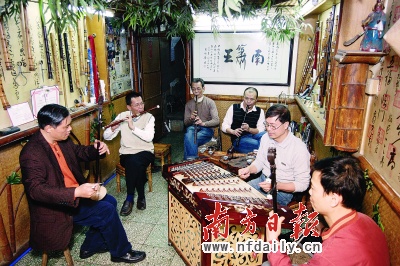 |
| People gather together playing Guangdong music. |
Guangdong music, also known as Cantonese music, is a style of traditional Chinese instrumental music from Guangzhou and the surrounding areas. It is based on Yueju (Cantonese opera) music, together with new compositions from the 1920s onwards. Many pieces have influences from jazz and western music, using syncopation and triple time. It has a history of more than four hundred years. In the latter half of the 19th Century, Guangdong music was prevalent in the Guangzhou dialect speaking area, including the Pearl River Delta. It started to become popular both in China and abroad in the early years of the 20th Century.
The early ensembles around 1919 consisted of the two-stringed Tiqin (an instrument similar to the Banhu), the three-stringed Yueqin and the horizontal flute. Such orchestras were called "five frames" or "hard groups". Solos were mostly played on Pipa or Yangqin. As the 20th Century progressed, Gaohu became the main instrument, backed up by the Yangqin and Qinqin. These three were commonly known as the "frio" or "soft bow". Gaohu was said to be the lead instrument or for special renditions. The Gaohu is basically similar to the Erhu (two-stringed Chinese fiddle), except that the sound box is smaller.
Most pieces of Guangdong music came from folk music. It was not until the 1920s that a batch of composers of Guangdong music created about 500 works, greatly enriching the treasury of Guangdong music. For instance, at the beginning of the 20th Century, folk artist Lu Wencheng changed the usual silk strings of the Erhu to steel ones, raising its register four or five octaves, and giving it a brighter tone. During performances, he would hold the sound box between his legs in order to better control the pitch.
Guangdong music is good at depicting the minor facets of life, as well as being closely connected with revealing traditional emotions. To appreciate it, one should not be on the lookout for the great themes of social life, but for descriptions of natural scenery and objects, which bring a feeling of relaxation. Some of the finer pieces of music in this genre are as follows.
Rain on the Plantain Leaves. This was one of the earliest compositions of this type. Its smooth and lively melody expresses the pleasant mood of life in south China. The notes are pure, to represent the pattering of raindrops on plantain leaves, the swaying of the leaves under their impact, and the delight with which people welcome rain after a drought.
Hungry Horse Shakes Its Bells. This was transcribed by He Liutang from an instrumental piece with Pipa as the leading instrument, and rearranged for strings. Its technique of using pure notes in quavering rhythms, with the notes So and Fa prominent, manages to convey the very image of a horse shaking its harness bells to express its hunger to its master.
Autumn Moon on the Calm Lake. This is a representative piece by the master of Guangdong music Lu Wencheng, which he composed to express his admiration of the beautiful scenery of the West Lake, which he saw on an autumn visit to Hangzhou. The tune combines elements of Zhejiang folk music with the Guangdong style. It has one of the most outstanding melodies in Chinese instrumental music.
Dragon Soars and the Phoenix Dances. A dragon dance with lanterns is indispensable at folk festivals, when the Chinese people welcome a change of season. Besides, in Chinese psychology dragons and phoenixes are symbols of all that is wonderful and auspicious. This work employs a syncopated rhythm with a strong driving force. It is highly modulated, stepping forward and back, and shifting and turning, in the same way a dancer does. The clear notes of the small gong, the squeal of suona and the harmonious plucking of stringed instruments all combine to create a joyous atmosphere.
Han Palace in the Autumn Moonlight (also known as The Three Ponds Reflecting the Moon) This traditional Chinese instrumental piece has been rearranged many times throughout its long history, so it is now a long way from its original musical form. The Han Palace in the Autumn Moonlight was originally a mournful tune, while all traces of sorrow were removed in its reincarnation as The Three Ponds Reflecting the Moon. This work was based on a Northern Tune, to which were added a large number of fine embellishments adopted from the vocabulary of Guangdong music, and so the wide-ranging boldness of the northern music was transformed into the refreshing fineness of the Guangdong style.
Guangdong music enjoys a high reputation among Chinese people abroad. It is a tie between the overseas Chinese and their country; it makes great contributions in continuing the best of the rich and colorful national music for Chinese people abroad.
As an excellent representative of Lingnan culture, Guangdong musical culture is rich in profound basis and connotation. After hundreds of years' of development, it formed its own style and musical system. However, it is facing huge challenges in succeeding nowadays; thus protection and support are urgently needed.